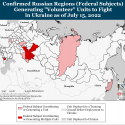Russian Offensive Campaign Assessment, July 20
Jul 20, 2022 - ISW Press
The current Russian offensive may secure limited additional territorial gains in Donbas northeast of the E40 highway but will likely culminate before seizing major populated areas such as Slovyansk or Bakhmut. Russian forces have not made significant advances towards Slovyansk or along the Siversk-Bakhmut salient in the past few weeks and are continuing to degrade their own offensive combat power in localized fights for small and relatively un-important settlements throughout Donetsk Oblast. Russian troops have notably been attempting to take Siversk since the capture of Lysychansk and the Luhansk Oblast border on July 3 and have still not reached the city as of July 20. Similarly, Russian troops have failed to launch direct assaults on Bakhmut and have largely impaled themselves on fights for small settlements to its east and south. Efforts to advance on Slovyansk have mostly ground to a halt and have made no meaningful gains for weeks. The renewal of active ground offensives following the brief operational pause has not yet translated into meaningful Russian forward progress, although it is possible that either steady Russian pressure or the completion of Russian efforts to rebuild combat power could generate limited gains in the coming days or weeks.







